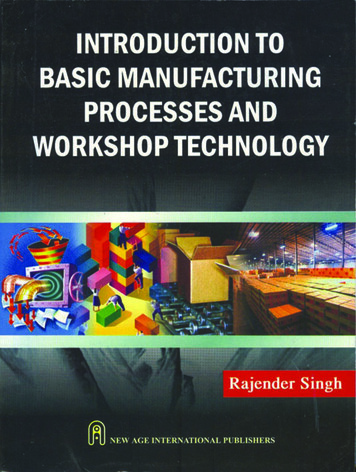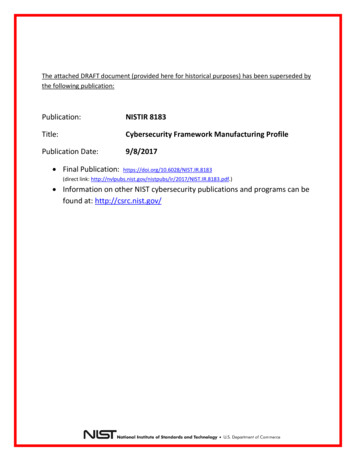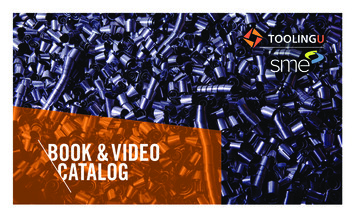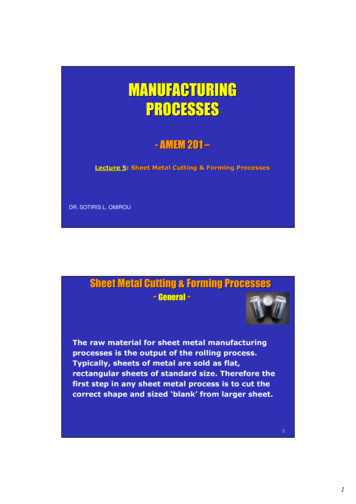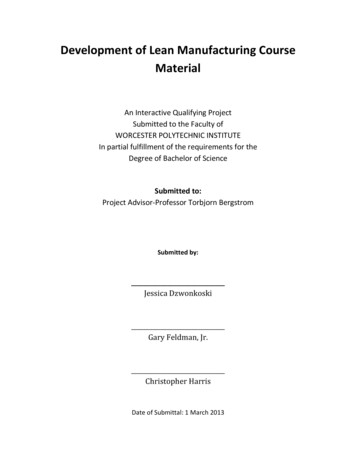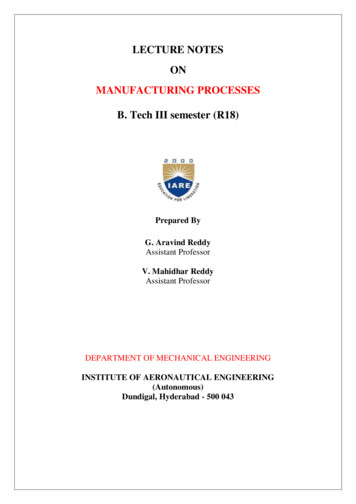
Transcription
LECTURE NOTESONMANUFACTURING PROCESSESB. Tech III semester (R18)Prepared ByG. Aravind ReddyAssistant ProfessorV. Mahidhar ReddyAssistant ProfessorDEPARTMENT OF MECHANICAL ENGINEERINGINSTITUTE OF AERONAUTICAL ENGINEERING(Autonomous)Dundigal, Hyderabad - 500 043
MANUFACTURING PROCESSESIII Semester: MECourse CodeCategoryAMEB05CoreContact Classes: 45Tutorial Classes: NilHours / WeekCreditsMaximum MarksLTPCCIASEETotal30033070100Practical Classes: NilTotal Classes: 45COURSE OBJECTIVES:The course should enable the students to:I. Understand and develop an appreciation of the manufacturing processes in correlation with materialproperties.II. Learn the material properties which change the shape, size and form of the raw materials into thedesirable product.III. Understand the processes for creating products by conventional or unconventional manufacturingmethods.MODULE-ICASTINGClasses: 09Casting: Steps involved in making a casting, its applications, patterns and types of patterns,patternallowances and their construction, types of casting processes, solidification of casting.MODULE-IIWELDINGClasses: 09Welding: Welding types, Oxy-fuel gas welding, cutting, standard time and cost calculations, arc weldingProcess, forge welding, resistance welding, thermit welding.Inert gas welding, TIG welding, MIG welding,friction welding, induction pressure welding,explosive welding, electron beam welding, laser welding,soldering and brazing.Heat affected zone in welding, welding defects, causes and remedies, destructive andnon-destructivetesting of welds.MODULE-IIIMETAL FORMINGClasses: 09Forming: Hot working, cold working, strain hardening, recovery, re-crystallization and graingrowth,comparison of properties of cold and hot worked parts, rolling fundamentals, theory of rolling, typesofrolling mills and products;Forces in rolling and power requirements, stamping, forming and other cold.Working processes: Blankingand piercing, bending and forming, drawing and its types, wire drawing andtube drawing; coining; hot andcold spinning, types of presses and press tools, forces and powerrequirements for the above operations.MODULE-IVEXTRUSIONAND RAPID PROTOTYPINGClasses: 09Extrusion of Metals: Basic extrusion process and its characteristics, hot extrusion and cold extrusion,forward extrusion and backward extrusion, impact extrusion, extruding equipment, tube extrusion and Pipemaking, hydrostatic extrusion, forces in extrusion; Additive manufacturing: Rapid prototyping and rapidtooling.
MODULE-VFORGINGClasses: 09Forging processes: Forging operations and principles, tools, forging methods, Smith forging, drop forging,roll forging, forging hammers: Rotary forging, forging defects, cold forging, swaging, forces in forgingoperations.Text Books:1.Kalpakjian and Schmid, Manufacturing processes for engineering materials -Pearson India, 5th Edition2014.Reference Books:1. Mikell P. Groover, Fundamentals of Modern Manufacturing: Materials, Processes, and Systems JohnWiley & Sons Inc., 4th Edition, 2008.2. Degarmo, Black &Kohser, Materials and Processes in Manufacturing (9th Edition) John Wiley & SonsInc.,7th Edition, 2012.Web t/Manufacturing Processes Reference Guide.html?id 6x1smAf PAcCE-Text Books:1.https://books.google.co.in/books?id 6wFuw6wufTMC&printsec frontcover#v onepage&q&f false
MODULE-ICASTING
MODULE-IIWELDING
Brazing:
MODULE-IIIMETAL FORMING
Flat Rolling
MODULE-IVEXTRUSIONAND RAPID PROTOTYPING
Extrusion is a process in which the metal is subjected to plastic flow by enclosing the metal in aclosedchamber in which the only opening provided is through a die. The material is usually treated so thatitcan undergo plastic deformation at a sufficiently rapid rate and may be squeezed out of the hole in thedie. Inthe process the metal assumes the opening provided in the die and comes out as a long strip withthe samecross-section as the die-opening. Incidentally, the metal strip produced will have a longitudinalgrain flow.Theprocess of extrusion is most commonly used for the manufacture of solid and hollow sectionsof nonferrousmetals and alloys e.g., aluminium, aluminium-magnesium alloys, magnesium andits alloys, copper, brass andbronze etc. However, some steel products are also made by extrusion.The stock or the material to be extruded is in the shape of cast ingots or billets. Extrusion maybe donehot or cold. The cross-sections of extruded products vary widely. Some of these sections areshown inFigure aboveEXTRUSION PROCESSESExtrusion processes can be classified as followed:(A) Hot Extrusion(i) Forward or Direct extrusion.(ii) Backward or Indirect extrusion.(B) Cold Extrusion(i) Hooker extrusion.(ii) Hydrostatic extrusion.(iii) Impact extrusion.(iv) Cold extrusion forging.Forward or direct extrusion process: In this process, the material to be extruded is in the form of ablock. It is heated to requisite temperature and then it is transferred inside a chamber as shown inFigure. In the front portion of the chamber, a die with an opening in the shape of the cross-section ofthe extruded product, is fitted. The block of material is pressed from behind by means of a ram and afollower pad. Since the chamber is closed on all sides, the heated material is forced to squeezethrough the die-opening in the form of a long strip of the required cross-section.
Backward or indirect extrusion: This process is depicted in Figure As shown; the blockof heatedmetal is inserted into the container/chamber. It is confined on all sides by the container wallsexcept infront; where a ram with the die presses upon the material. As the ram presses backwards, thematerialhas to flow forwards through the opening in the die. The ram is made hollow so that the barofextruded metal may pass through it unhindered.This process is called backward extrusion process as the flow of material is in a direction oppositeto the movement of the ram. In the forward extrusion process the flow of material and ram movementwere both in the same direction. The following table compares the forwards (direct) and backwards(Indirect extrusion process).Hooker extrusion process: This process is also known as extrusion down method. It is usedforproducing small thin walled seamless tubes of aluminium and copper. This is done in two stages.In thefirst stage the blank is converted into a cup shaped piece. In the second stage, the walls of thecup onethinned and it is elongated. The process can be understood by referring to Figure. This processis adirect extrusion process.Hydrostatic extrusion: This is a direct extrusion process. But the pressure is applied to the metalblank on all sides through a fluid medium. The fluids commonly used are glycerine, ethyl glycol,mineral oils, castor oil mixed with alcohol etc. Very high pressures are used – 1000 to 3000 MPa.Relatively brittle materials can also be successfully extruded by this method.Impact extrusion: In this process, which is shown in Figure below the punch descends with highvelocity and strikes in the centre of the blank which is placed in a die. The material deforms and fillsup the annular space between the die and the punch flowing upwards. Before the use of laminatedplastic for manufacturing tooth paste, shaving cream tubes etc., these collapsible tubes containingpaste were and are still made by this process. This process is actually a backward extrusion process .
Cold extrusion forging: This process is depicted in Figure below. This is generally similar to theimpactextrusion process; but there are two differences:1. In this process the punch descends slowly,and2. The height of extruded product is short and the side walls are much thicker than the thinwalledproducts produced by the impact extrusion process. In essence, this process is one ofbackwardextrusion.MACHINES FOR EXTRUSIONBoth hydraulic and mechanical presses of horizontal and vertical configuration are used forextrusion.They should be capable of exerting high forces and their rams should have long strokes. Toreducefriction between metal and extrusion chamber walls, lubricants are used. The dies and punchesaremade from good quality alloy steels which are known as hot and cold die steels.Extrusion speed is ofthe order of 0.5 m/sec for light alloys and 4.5 m/sec for copper alloys.EXTRUSION DEFECTSSometimes the surface of extruded metal/products develop surface cracks. This is due to heatgeneratedin the extrusion process. These cracks are specially associated with aluminium, magnesiumand zincalloy extrusions.The extruded product can develop internal cracks also. These are variouslyknown as centreburst, centre cracking and arrowhead fracture. The tendency for centre crackingincreases with increasingdie angles and material impurities.WIRE DRAWINGWire drawing is a simple process. In this process, rods made of steel or non ferrous metals and alloysare pulled through conical dies having a hole in the centre. The included angle of the cone iskeptbetween 8 to 24 . As the material is pulled through the cone, it undergoes plastic deformation anditgradually undergoes a reduction in its diameter. At the sametime, the length is increasedproportionately.
The dies tend to wear out fast due to continuous rubbing of metal being pulled through it. Hencethey are made of very hard material like alloysteel, tungsten carbide or even diamond. In one pass,thereduction in cross-sectional area achieved is about 25–30%. Hence in a wire drawing plant, thewire hasto pass through a number of dies of progressively reducing diameter to achieve the requiredreduction indiameter. However as the wire passes through dies and undergoes plastic deformation, itgets strainhardened. Its strength increases and capacity to further undergo plastic deformationdecreases. Thereforeduring the entire run of the wire, from time to time, it has to be heated (andcooled) to remove theeffect of work-hardening. This process is called “in process annealing”. The aimis to make the materialsoft and ductile again so that the process of drawing may be smoothly carriedout.The metal rods to be drawn into wires must be absolutely clean. If necessary, they are pickled inanacid bath to dissolve the oxide layer present on the surface. Its front end is then tapered down so thatitmay pass through the hole in the die which is firmly held in the wire drawing machine. The wireisdrawn by means of a number of power driven spools or rotating drums.During wire drawing, a great deal of heat is generated due to friction between the wire rod andthe die.To reduce friction, dry soap or a synthetic lubricant is used. But despite reducing friction, thedies anddrums may have to be water cooled.The preferred material for dies is tungsten carbide but for drawingfine wire, use of ruby ordiamond dies is preferred.The drawing machines can be arranged in tandem so that the wire drawn by the previous die maybecollected (in coil form) in sufficient quantity before being fed into the next die for further reductionindiameter. As the diameter becomes smaller, the linear speed of wire drawing is increased.The major variables in wire drawing process are (1) Reduction ratio (2) Die angle and (3) Friction.Improper control of these parameters will cause defects in the drawn material. Defects includecentre cracking (as in extrusion and for the same reasons) and formation of longitudinal scratches orfolds in the material.TUBE DRAWINGThe ‘drawing’ process can also be used for tube drawing. Tube drawing does not mean manufacturinga tube from solid raw material. It means lengthening a tube reducing its diameter.Variousarrangementsused for tube drawing as shown in figure belowThe method shown in Fig. (a) is the most common method used for tube drawing. A conventionaltube drawing bench is used. Methodshown in Fig. (b) Employs a floating mandrel. Method shown inFig. (c) uses a long circular rod to control the size of tube-bore. Method shown inFig.(d) uses neither amandrel nor a bar and controlling size of bore is difficult .
TUBE MAKINGTubes and pipes are required in large quantities by industries all over the world. Tubes are basically oftwo types. They are either seamless (i.e., without any joint) or with joint all along the length of thetube. Seamless tubes are made by processes such as casting, extrusion or rolling. Tubes with joint aremade by welding. Usually, the weld joint is made by electric resistance welding process, such tubesare referred to as ERW tubes. The size of a tube or pipe is indicated by the size of its bore in mm.Since the requirement of tubes is so large, a special rolling process called Mannesmann rotarypiercing process has been developed. In this process, a heated round billet with its leading end, in thecentre of which a short guide hole has been punched or drilled, is pushed longitudinally between twolarge tapered rolls as shown in Figure belowThe rolls revolve in the same direction and their axes are inclined at opposite angles of approx 6 fromthe axis of the billet. As the billet is caught by the rolls and is rotated, their inclination causes thematerial to be drawn forward. The small clearance between the rolls forces the material to deform intoan elliptical shape. Due to compressive forces, secondary tensile stresses start acting in a directionperpendicular to the direction of the compressive stresses. The guide hole drilled/punched at centre ofbillet tears open. This action is assisted by a suitably placed mandrel.As the billet mores forward and keeps rotating the tearing action is propagated throughout thelengthof the billet. End result is a roughly formed seamless tube of ellipitical cross-section.This roughlyformed seamless tube is further rolled in a “plug rolling mill”. The final operationsof “reeling” and“sizing” are further conducted on cooled tube to improves size and finish of tubes.Rapid prototypingThough the principle of concurrent engineering (CE) is quite clear and the advantages of the conceptfor improved quality and reduced cost are implicit, it is not possible to incorporate CE effectively inthe absence of some technique for quick development of prototype. To reduce the development timeand adopt concurrent engineering in its true spirit, quick and inexpensive fabrication of prototypeparts is essential and rapid prototyping technology has made that possible. A family of uniquefabrication processes developed to make engineering prototypes in minimum lead time based on aCAD model of the item. The traditional method is machining Machining can require significantlead-times –several weeks, depending on part complexity and difficulty in ordering materials RPallows a part to be made in hours or days given that a computer model of the part has been generatedon a CAD system.
Why Rapid Prototyping? Because product designers would like to have a physical model of a newpart or product design rather than just a computer model or line drawing Creating a prototype is anintegral step in design A virtual prototype (a computer model of the part design on a CAD system)may not be sufficient for the designer to visualize the part adequately Using RP to make theprototype, the designer can visually examine and physically feel the part and assess its merits andshortcomings.Basic principles of RPIn this process a solid object with prescribed shape, dimension and finish can be directly producedfrom the CAD based geometric model data stored in a computer without human intervention.Conventional method for producing parts like casting, forming, machining etc are not suitable for thispurpose and a host of new processes for shaping objects directly from the CAD data have beendeveloped and machines are in the market. Rapid prototyping can be of two types: The partsobtained by RP technology can form the prototype directly without requiring any further processing.The parts obtained by RP technology can be used to make moulds for casting the prototypecomponent. This type is needed because till today, the commercially available RP machines are nonmetallic materials with low strength and low melting temperature. In general this technology is calledas Generative manufacturing Process (GMP) as the shape of the work piece is not obtained byremoval of chips or forming or casting. It is achieved by addition of material without any priorrecognizable form or shape and no tool is necessary.The slice thickness and slicing direction can be varied for convenience of generation. To generate anobject of same shape as that of sliced CAD model, the distance between the slicing planes (t) must beequal to the thickness of the corresponding layers during the actual generation process.
MODULE-VFORGING
Forging processes: Forging operations and principles, tools, forging methods, Smith forging, drop forging, roll forging, forging hammers: Rotary forging, forging defects, cold forging, swaging, forces in forging operations. Text Books: 1.Kalpakjian and Schmid, Manufacturing processes for enginee


